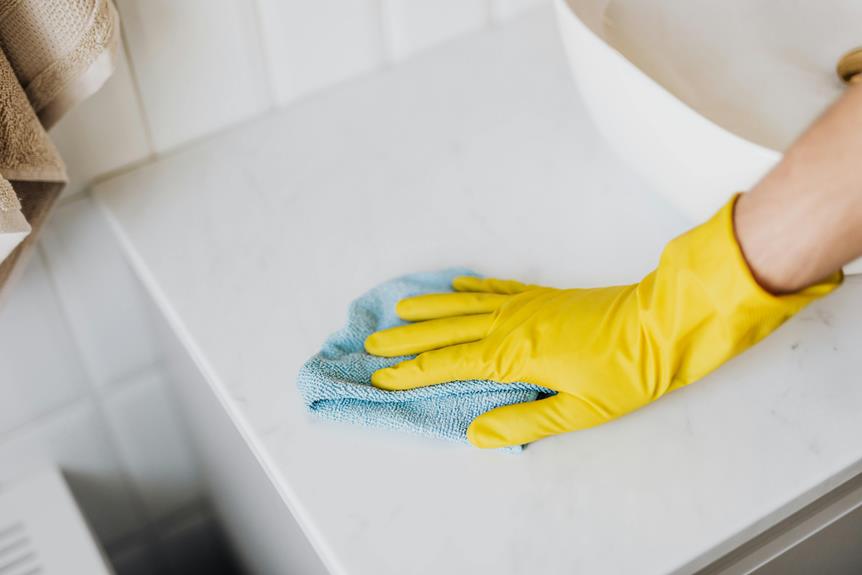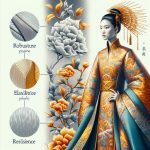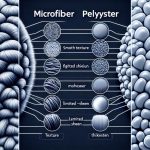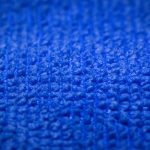When you think of fabric, you might picture cotton or wool, but have you considered microfiber? This innovative synthetic material, made from ultra-fine fibers, redefines what you expect from textiles. Its unique composition offers impressive absorbency and durability, making it a go-to for various applications. However, the benefits don't stop there—understanding how microfiber is made and its environmental impact can reshape your choices in fabric use. Curious about how this fabric stacks up in your everyday life? Let's explore its many facets together.
Table of Contents
Key Takeaways
- Microfiber is a synthetic fabric made from ultra-fine polyester and polyamide fibers, known for its softness and durability.
- It absorbs up to seven times its weight in liquid, making it highly effective for cleaning and drying tasks.
- The fabric is hypoallergenic, making it suitable for individuals with allergies or sensitive skin.
- Microfiber is resistant to fraying and tearing, providing long-lasting use with minimal maintenance.
Definition of Microfiber Fabric
Microfiber fabric is a synthetic material made from extremely fine fibers, typically measuring less than one denier in diameter. This unique structure gives microfiber its remarkable properties.
You'll find it primarily made from polyester, polyamide, or a blend of both, which contributes to its softness and durability. When you touch microfiber, you'll notice its silky feel, which makes it ideal for various applications.
It's lightweight and highly absorbent, making it perfect for cleaning products and clothing. You can also use it in upholstery, offering a luxurious look without the hefty price tag.
One of the standout features of microfiber is its ability to trap dirt and dust effectively. This makes it a favorite for cleaning enthusiasts. It's also resistant to stains, which means your investment will last longer.
In addition, microfiber is often hypoallergenic, making it suitable for those with allergies or sensitive skin. When you choose microfiber, you're opting for a versatile, functional, and stylish fabric that meets diverse needs, enhancing your home or wardrobe while simplifying your daily tasks.
Composition and Structure
Made from a blend of polyester and polyamide, the composition of microfiber gives it its unique softness and strength. This combination results in fibers that are incredibly fine—often thinner than a human hair. You'll find that the typical diameter of microfiber is around 0.1 denier, which allows it to capture dirt, dust, and moisture more effectively than coarser fabrics.
In terms of structure, microfiber consists of a denser weave compared to traditional textiles. This dense construction contributes to its durability and resistance to wear and tear. When you touch microfiber, you'll notice its velvety texture, which is a direct result of the fine fibers being tightly woven together.
Additionally, the structure of microfiber allows for excellent breathability, making it suitable for various applications, from cleaning cloths to clothing. You'll also appreciate how easily it can be dyed, allowing for a wide range of colors and patterns.
Key Properties of Microfiber
When you choose microfiber, you're benefiting from its superior absorbency that outperforms many other fabrics.
Its durability ensures that it stands the test of time, making it a smart investment for various uses.
You'll find that these key properties make microfiber a versatile option in your fabric choices.
Superior Absorbency Characteristics
With its unique structure, microfiber absorbs up to seven times its weight in liquid, making it an exceptional choice for cleaning and drying. This incredible absorbency comes from the fibers' small size and high surface area, allowing them to soak up moisture quickly and efficiently.
When you use microfiber cloths, you'll notice they pick up spills and wipe surfaces dry without leaving streaks or lint behind. In practical terms, this means you can tackle a variety of tasks, from mopping floors to drying dishes, with just one cloth.
Since microfiber traps dirt and grime within its fibers, you won't need to rely heavily on cleaning solutions, which can save you money and reduce chemicals in your home.
Moreover, the absorbency of microfiber extends beyond just liquid; it can also capture dust and allergens, making it a great choice for those with sensitivities. You'll appreciate how quickly and effectively it cleans, leaving surfaces not only dry but also free of harmful particles.
In short, microfiber's superior absorbency makes it an indispensable tool in your cleaning arsenal!
Durability and Longevity Factors
Microfiber's impressive durability ensures that your cleaning tools last longer, making them a worthwhile investment for any household. Unlike traditional fabrics, microfiber resists wear and tear, allowing you to use it repeatedly without compromising its effectiveness. This longevity means you can tackle tough cleaning tasks without worrying about replacing your tools frequently.
Key factors contributing to microfiber's durability include:
- Strong Fiber Structure: Microfiber is made from tightly woven synthetic fibers, which provide resistance against fraying and tearing.
- Chemical Resistance: Microfiber can withstand various cleaning agents, ensuring it maintains its integrity even after multiple washes.
Benefits of Using Microfiber
When you choose microfiber, you're tapping into a fabric that's super absorbent and incredibly durable.
It not only lasts long but also offers eco-friendly options that help you make sustainable choices.
Let's explore how these benefits can enhance your everyday life.
Super Absorbent Material
Thanks to its unique structure, microfiber fabric excels at soaking up moisture, making it a go-to choice for efficient cleaning and drying. Whether you're tackling spills or cleaning surfaces, microfiber's super absorbent properties can make your tasks much easier. You'll find it's incredibly effective at trapping water and grime, leaving surfaces spotless.
Here are a few benefits of using microfiber for absorption:
- Quick Drying: Microfiber dries faster than traditional materials, reducing the chances of mold and bacteria growth.
- Less Water Needed: You won't need to soak your cleaning cloths; just a little moisture goes a long way.
When you use microfiber, you'll notice how effortlessly it absorbs liquids. This not only saves you time but also helps maintain a cleaner environment. Its ability to hold up to seven times its weight in water makes it a standout choice for cleaning tasks.
With microfiber, you're investing in a material designed for efficiency—perfect for your everyday needs.
Durable and Long-lasting
Known for its impressive resilience, microfiber fabric can withstand frequent use and laundering without losing its effectiveness or integrity. This durability makes it an excellent choice for various applications, from cleaning cloths to upholstery. When you choose microfiber, you're investing in a material that stands the test of time.
Microfiber's tightly woven fibers create a strong structure, allowing it to resist wear and tear. Unlike cotton or other fabrics, it doesn't fray or fade easily, ensuring that your items maintain their appearance even after numerous washes.
You'll appreciate how it holds up against stains, making it easier to keep your belongings looking fresh and clean. Additionally, microfiber's lightweight nature means it's less likely to become misshapen or stretched out, maintaining its original form.
Whether you're using it for household cleaning, clothing, or furniture, you can count on its long-lasting performance.
Eco-Friendly Options Available
Microfiber often provides an eco-friendly alternative to traditional cleaning materials, helping you reduce waste and chemical usage. By choosing microfiber, you're not just making a smart choice for your home; you're also contributing to a healthier planet.
Here are some key benefits:
- Less Water Usage: Microfiber requires significantly less water to clean surfaces compared to conventional cloths. This means you can effectively clean while conserving water.
- Reduced Chemical Dependency: You can often clean with just water and microfiber, minimizing the need for harsh cleaning chemicals. This is better for your health and the environment.
Common Applications
When you consider its versatility, microfiber fabric is commonly used in everything from cleaning cloths to upholstery. You'll find it in various household items, including towels, sheets, and even curtains. Its ultra-fine fibers create a soft texture that feels luxurious while being highly functional.
In the cleaning world, microfiber's ability to trap dirt and dust makes it a preferred choice for many. Whether you're wiping down surfaces or dusting furniture, you'll appreciate how effectively it picks up particles without the need for harsh chemicals.
In the fashion industry, microfiber is often used for clothing, especially activewear. Its moisture-wicking properties keep you dry during workouts, and its lightweight nature adds comfort. Additionally, you might notice microfiber in accessories such as handbags and wallets, where durability and style come together.
For those with pets, microfiber is a popular choice for pet beds and throws, as it's resistant to stains and easy to clean. With its myriad of applications across different industries, microfiber fabric proves to be an essential material in your daily life.
Care and Maintenance
Proper care and maintenance of microfiber fabric ensures its longevity and performance in various applications. To keep your microfiber items in top shape, follow these simple guidelines.
First, always wash them in cold water with a mild detergent. Hot water can damage the fibers and reduce their effectiveness.
Second, avoid using fabric softeners, as they can coat the fibers and diminish their absorbency.
Here's a quick list to help you remember the key points:
- Wash with cold water and mild detergent: This prevents damage and maintains performance.
- Skip fabric softeners: They can reduce absorbency and create a film on the fabric.
Environmental Impact
Understanding the environmental impact of microfiber fabric is important, especially as you consider its care and maintenance in your daily routine. While microfiber is praised for its durability and effective cleaning capabilities, it poses significant environmental concerns.
When you wash microfiber products, tiny plastic fibers can shed and enter waterways, contributing to microplastic pollution. These microplastics are harmful to aquatic life and can eventually make their way into the food chain.
Moreover, microfiber is often made from synthetic materials like polyester and nylon, which are derived from fossil fuels. This production process contributes to greenhouse gas emissions and environmental degradation. You might think that the benefits of microfiber outweigh these issues, but it's crucial to weigh the pros and cons carefully.
To minimize the environmental impact, consider reducing washing frequency, using a Guppyfriend bag to catch microfibers, and opting for high-quality microfiber that lasts longer. You can also explore alternatives like natural fibers, which may have a smaller ecological footprint.
Frequently Asked Questions
Can Microfiber Fabric Be Recycled or Composted?
Microfiber fabric can't be easily recycled or composted due to its synthetic nature. You should check local recycling programs for any guidelines, but generally, it's better to repurpose or donate your microfiber items instead.
Is Microfiber Fabric Safe for Sensitive Skin?
Yes, microfiber fabric is generally safe for sensitive skin. It's soft, hypoallergenic, and breathable, reducing irritation. Just make sure it's clean and properly washed, as residues from detergents can sometimes cause reactions.
How Does Microfiber Compare to Cotton in Durability?
When you compare microfiber to cotton, you'll find microfiber's fibers are denser and stronger, making it more durable. It resists wear and tear better, so it lasts longer in everyday use than cotton does.
Are There Any Allergens Associated With Microfiber Fabric?
Microfiber fabric typically doesn't harbor allergens like dust mites or mold, making it a great choice for those with sensitivities. It's also easy to clean, reducing the chance of allergen accumulation in your home.
Can Microfiber Fabric Be Dyed or Printed On?
Yes, you can dye or print on microfiber fabric, but results vary. It's best to use specific dyes formulated for synthetic materials. Always test on a small area first to ensure you achieve the desired effect.
- Tetron Fabric HS Code: Import and Export Information - June 17, 2025
- Tetron Fabric 36 Length of Roll: What You Need to Know - June 17, 2025
- Tetron Fabric 36: Specifications and Uses - June 17, 2025






